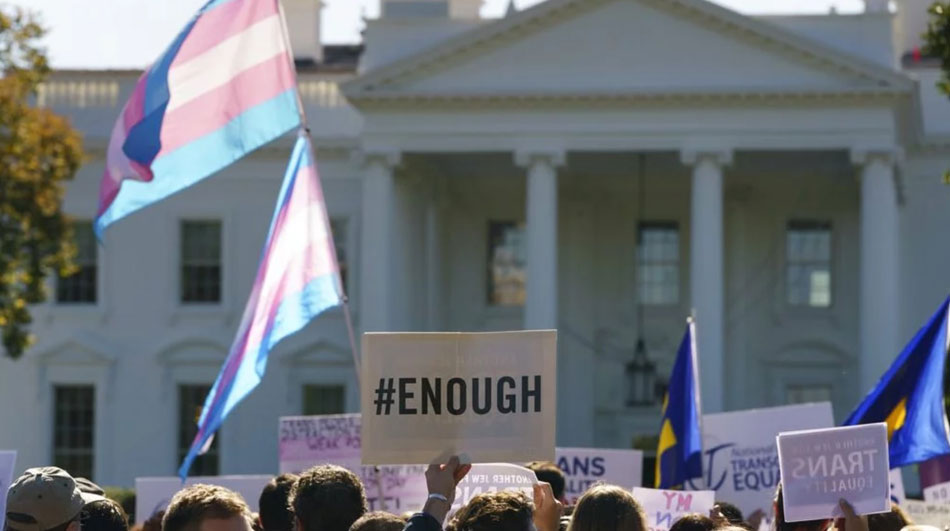
Trans men and non-binary individuals are being left out of reproductive rights conversations. During the last four months, a number of draconian bills have swept the nation. States like Alabama, Georgia, Missouri, and Ohio voted on and passed near-total abortion bans.
Since then, several of the bills have been challenged in lower courts. But it’s expected that many of the controversial bills will eventually end up at the Supreme Court for review.
Amid the nationwide conversation surrounding reproductive rights, pro-choice advocates have taken up mantras of defiance, such as “a woman’s body, a woman’s right to chose.” While it remains true that anti-abortion legislation is drafted in a way that targets cisgender women, the discourse fails to address another community directly impacted by recent attacks on bodily autonomy: trans men and non-binary individuals.
Much of the misinformation regarding trans reproductive rights is due to the fact that there is a lack of acknowledgment of trans and non-binary bodies within the medical industrial complex. The erasure of trans individuals, even within LGBTQIA+ spaces, is commonplace and highlights a blind spot in the conversation around reproductive rights.
Trump’s 2018 proposal to rescind federal recognition of transgender, intersex, and gender non-binary individuals is an extension of this same issue. It is indicative of the institutionalized erasure that has contributed to harmful medical practices on trans and intersex communities. The binary nature of medical linguistics is naturally carried over into reproductive rights policies, consequently hurting some of the most medically vulnerable populations.
Despite the ongoing struggle to be acknowledged, there are a number of young trans people across the nation who have benefited from access to abortions. “Having an abortion saved me,” says 27-year-old Yun Baek. The Chicago based pre-school teacher has openly presented as a man for a little over two years, and identified as non-binary for a year before that.
Stopping the abortion bans is a working-class fight—Here’s why
Although not often acknowledged by medical professionals, trans men and non-binary individuals who are AFAB (assigned female at birth) are often still capable of becoming pregnant. Regardless of prior hormone replacement therapy treatments, the progression of pregnancy and birthing procedures are typically the same for trans men as they are for cisgender women.
In his early twenties, Baek (who presented as a “woman” at the time) was involved in an abusive relationship with a domestic partner. Baek’s boyfriend exhibited violent behaviors due to issues with substance abuse, which is one of many reasons he decided to pursue an abortion. “The night I had the abortion, he left me bleeding on our bed to sell and do coke at clubs all night,” Baek recalls. It wasn’t until a month later that he mustered up the courage to move out.

Escaping the abusive dynamic allowed Baek a second chance to live authentically and safely. “If I was forced to have a baby, I don’t know if I would have transitioned.” The narrative of abortions being framed as consequences of “reckless” or irresponsible behavior is often misconstrued. In reality, over half of pregnancies in the United States are unintended, according to the Guttmacher Institute, which conducts reproductive health research.
According to studies conducted by the Washington Hospital Center Department of Obstetrics and Gynecology, pregnancy is possible for trans men who retain “functioning” ovaries and a uterus even after having otherwise physically transitioned to male. There have been several instances in which trans men undergo “medical transitions” but still maintain the ability to birth children.
A 2018 study conducted found that out of 450 self-identified trans individuals who participated, 71% were at potential risk of unintended pregnancy based on sexual attraction. An additional 6% reported an unplanned pregnancy, and 32% had chosen to have abortions. An overwhelming majority (93%) were pro-choice.
Many clinics, however, struggle with understanding how to assist transgender clients, especially given the rampant transphobia in the medical industry. Additionally, many trans and non-binary individuals report having gender dysphoria and feelings of isolation due to the drastic bodily changes which occur during pregnancy, such as enlarged breasts or hormone imbalance. The dysphoric aspect of pregnancy is amplified by the lack of institutional support and structural marginalization of trans communities.
For young vulnerable working-class queer people like Baek, having access to legal abortion in Illinois gave him an opportunity to live as his authentic self. “My abortion was not about death, it was about life,” says Baek, who feels that he was given a second chance. “My internal voice used to be in complete silence, but leaving my abuser put things into perspective.”
Attacks on reproductive health rights and violence against trans and non-binary communities are intertwined in a mutual struggle to regain bodily autonomy. Trans people frequently find themselves misgendered, or unsupported in the early stages of their pregnancy. Inaccessibility to these services may lead to an increased risk of unsafe or unhealthy practices.
“I’m just so grateful I found agency over my body,” says Baek. “It makes me so scared that soon others may not have the same opportunity.”









